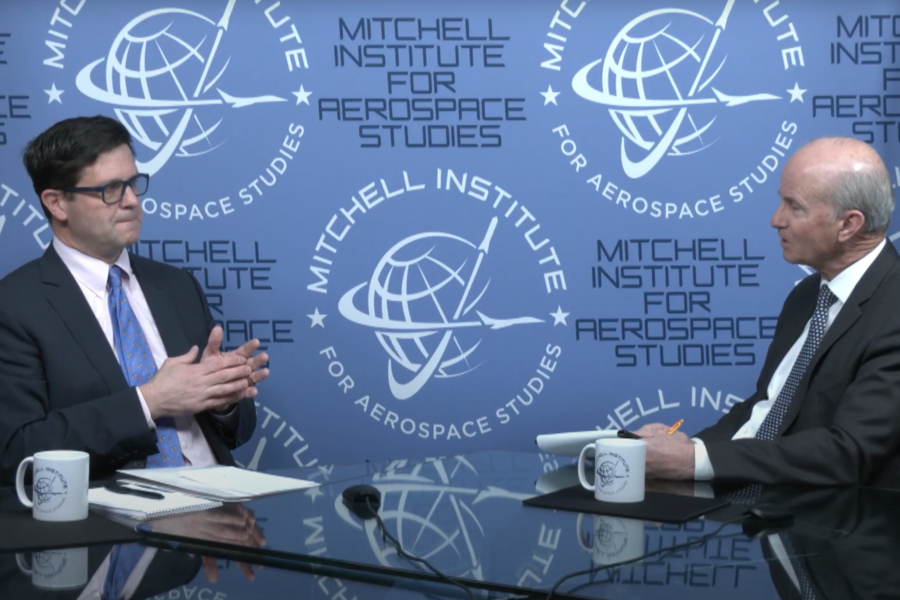The Space Force made resilience its No. 1 priority in 2022, with proliferated constellations of satellites a focus of this program to ensure systems remain operable even if some elements are lost. This year, resiliency is “baked into all the conversations,” said assistant secretary of Defense for space policy John F. Plumb, but the service now takes a more expansive view of the term.
“I think it is recognized now throughout the department that resilience isn’t just proliferated orbits,” Plumb said Feb. 14 on one of AFA’s Mitchell Institute for Aerospace Studies webcasts. “That may be part of it. But if your ground segment is one station, that’s not resilient at all. That’s not resilient against adversaries, that’s not even resilient against a power failure, perhaps.”
Resilience is more complicated than it seems at first, Plumb said. “There’s a lot of pieces to it,” he said. “It is one of these things that if you start to pull the thread, you can go farther and farther upstream on any particular piece, and you’re like, ‘Wow, this isn’t resilient.’ So there’s a lot to be done, but you can’t do everything.”
Concerns about ground stations as a potential “backdoor” through which adversaries might attack Space Force assets using cyber attacks have also been cited by Chief of Space Operations Gen. B. Chance Saltzman. Plumb acknowledged those risks, and said the Pentagon must do more to harden all its systems against cyber and related attacks.
“We have to get past the idea of just a fence or a shell. We have to do defensive depth. The [Cyberspace Solarium Commission] would say that’s not just for satellites, it’s for all infrastructure,” Plumb said. “How do you do defensive depth of your satellite systems, both on ground and in space, so that even if an adversary has some access, the ability to do damage is minimal?”
Defense in depth joins “Zero Trust” as two key cybersecurity terms now being applied to space systems. Both apply to continuously verifying any user seeking access across a network, and minimizes the impact of any single breach.
Retired Air Force Gen. Kevin P. Chilton, who moderated the conversation with Plumb, noted that resiliency also applies to launch. Almost all Space Force launches today lift off from either Vandenberg Space Force Base, Calif., or Cape Canaveral Space Force Station, Fla. A few launch from NASA’s Wallops Flight Facility in Virginia.
“All three launch infrastructures are on the coast and they’re fixed, and so a little vulnerable to attack more than, say a mobile launch capability or an airborne launch capability,” said Chilton, a former head of Air Force Space Command. “Imagine some of these smaller rockets maybe being able to launch from inland locations—the deserts of Nevada, California, places like that,” he said.
Now the explorer chair of the Mitchell Institute’s Spacepower Advantage Center of Excellence (MI-SPACE), Chilton noted that the U.S. has traditionally avoided inland launches, but added, “The Chinese and Russians certainly do that. They launch from deep within their borders.”
Plumb agreed, saying different kinds of infrastructure could match the missions of different launches.
“There’s a fundamental difference between large [heavy rockets to geosynchronous orbit] and what some of these smaller commercial providers look like they might be able to provide, especially to [low-Earth orbit], with a smaller rocket, smaller footprint,” Plumb said. The question then becomes “How can we kind of use that diversification for resilience not only of our infrastructure, but potentially in some future situation where you actually trying to launch on response?”
Lawmakers have expressed strong support for “tactically responsive space”—the ability to launch satellites quickly following attacks or losses in order to rapidly reconstitute capability. That’s not easy, Plumb said, but added: “You’re going to see us trying to dig into that.“
Even looking beyond the U.S.’s own borders, Chilton pointed to the importance of allies and partners in ensuring the Pentagon has assured access to space—in addition to a whole host of other benefits.
“I think a lot of folks don’t appreciate the fact that geography matters. And so you know if you want to surveil the southern hemisphere space domain, you’ve got to be in the southern hemisphere,” Chilton said. “Unless you’re having a satellite on orbit, but even that has its limitations. So … our allies are going to be critical to not only space domain awareness, but perhaps launch resilience, perhaps some counter-space capabilities that they could bring to bear that would help protect our Soldiers, Sailors, Airmen, Marines, and Guardians that are operating this domain.”
